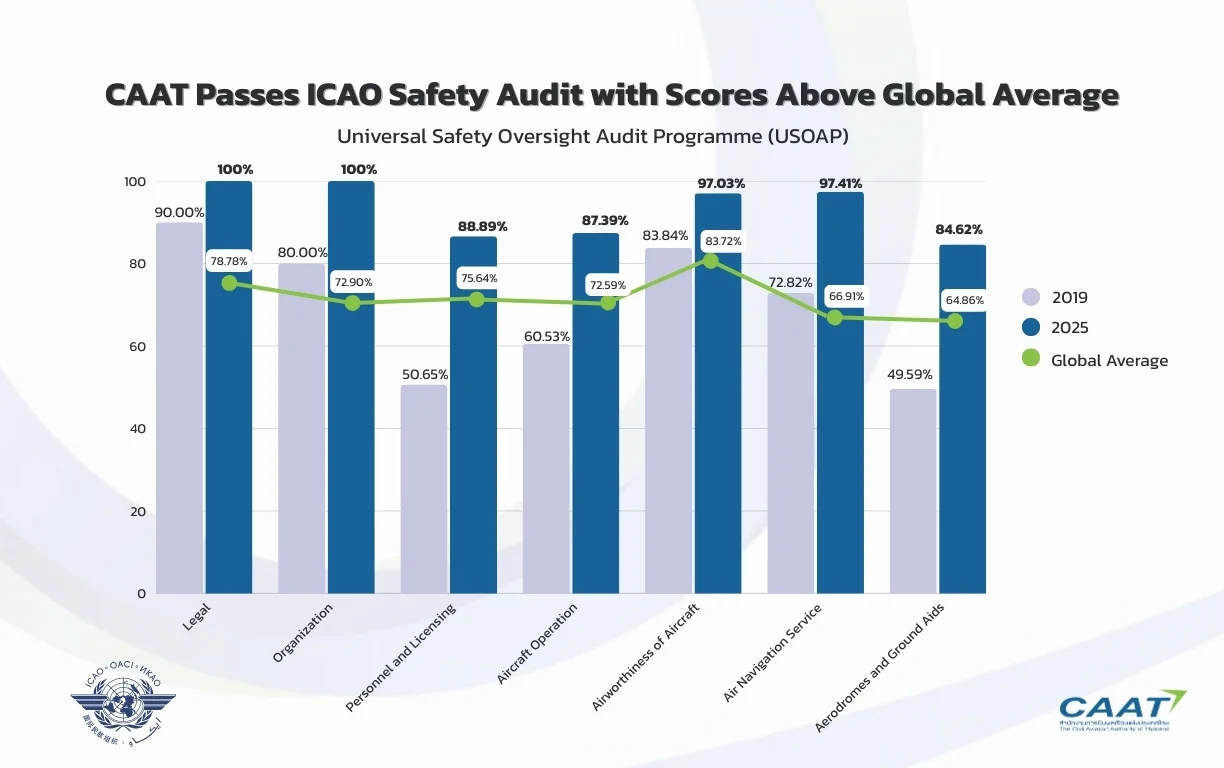
Thailand Tops Global Aviation Safety Scores at 91.35%, Surpassing the Global Average by Over 20%: CAAT
[ad_1]
The Civil Aviation Authority of Thailand (CAAT) introduced the outcomes of the audit on the civil aviation security oversight system below the Universal Safety Oversight Audit Programme – Continuous Monitoring Approach (USOAP CMA) of the International Civil Aviation Organization (ICAO), performed from 27 August to eight September 2025.
The preliminary outcomes, masking solely the areas below CAAT’s direct duty confirmed a preliminary rating as excessive as 91.35%, almost 20% above the international common of 70.50%.
The audit lined all eight key areas, particularly:
1. Primary Aviation Legislation and Civil Aviation Regulations (LEG)
2. Civil Aviation Organization (ORG)
3. Personnel Licensing (PEL)
4. Aircraft Operations (OPS)
5. Airworthiness of Aircraft (AIR)
6. Aircraft Accident and Incident Investigation (AIG)
7. Air Navigation Services (ANS)
8. Aerodromes and Ground Aids (AGA)
The preliminary outcomes, masking solely the areas below CAAT’s direct duty -namely laws, civil aviation group, plane operations, airworthiness, personnel licensing, air navigation providers, and aerodromes – confirmed a preliminary rating as excessive as 91.35%, almost 20% above the international common of 70.50%. ICAO might be sending a draft report back to be reviewed inside 90 days after the audit is accomplished, and the official scores are anticipated to be introduced on ICAO’s web site round February 2026.
Thailand achieved an ideal rating of 100% in two areas – Aviation Legislation (LEG) and Civil Aviation Organization (ORG) -exceeding the international common by 20–30%. This is ample proof that Thailand at present has a contemporary and complete aviation authorized framework aligned with worldwide requirements, together with a powerful, well-structured civil aviation authority on par with the world’s main aviation nations. It additionally demonstrates how far Thailand has come since being positioned below the ICAO “Red Flag” in 2015, underscoring the nation’s progress in direction of turning into a globally acknowledged aviation hub.
Thailand’s Aviation Safety Development Path
- January 2015: Thailand (then below the Department of Civil Aviation) underwent an audit that recognized 33 Significant Safety Concerns (SSC). As a outcome, ICAO issued a “Red Flag,” with Thailand’s Effective Implementation (EI) rating at 33.53%.
- September 2017: CAAT (Civil Aviation Authority of Thailand) resolved all deficiencies, main ICAO to take away the Red Flag; the EI rating rose to 41.11%.
- May 2019: All remaining deficiencies have been addressed (besides in AIG, attributable to ICAO’s scarcity of AIG consultants). The EI rating elevated to 65.83%.
- September 2021: ICAO performed an Offsite Validation focusing solely on AIG, with the EI rating recorded at 66.08%.
- January 2022: ICAO up to date its audit protocol from the PQ2017 Edition to PQ2020 for the USOAP-CMA, affecting the Effective Implementation (EI) scores of all states. Thailand’s EI rating was adjusted to 61.60%.
- July 2025: ICAO launched the new PQ2024 Edition, the newest set of standards for USOAP-CMA audits.
Preliminary Results
- Current Score (earlier than the audit): 61.60%
- Preliminary Score: 87.71%
- Preliminary Score (for areas below CAAT’s direct oversight – laws, civil aviation group, plane operations, airworthiness, personnel licensing, air navigation providers, and aerodromes): 91.35%
- Global Average: 70.50%
CAAT devoted the full experience of its personnel to arrange for this USOAP CMA audit, the largest in the previous decade since 2015. Air Chief Marshal Manat Chavanaprayoon, Director General of CAAT defined CAAT’s strategy to the ICAO evaluation that “ICAO provides Thailand with a checklist, questions, and guidance – the same procedure applied worldwide. Each CAAT division responsible for its respective area must work with its own team, covering legislation, operational procedures, and inspections of operators to ensure compliance with CAAT standards, thereby demonstrating the Authority’s oversight capability. Afterwards, ICAO reviews what CAAT has documented, such as regulations and operating procedures, to verify whether CAAT officials enforce them correctly, including applying penalties when operators or licensed personnel violate rules or laws. All these elements contribute to the high scores awarded by ICAO. This process reflects a comprehensive and transparent implementation of aviation law in line with international standards.”
CAAT will perpetually improve and uphold the requirements by way of ongoing growth. Significantly, this achievement was not completed by CAAT solitarily however by way of the collaboration of all stakeholders – together with Aeronautical Radio of Thailand Ltd., Airports of Thailand Plc., the Department of Airports, the Civil Aviation Training Center, airways, and all related associate companies. Their collective efforts drove this mission to success, giving confidence that Thailand will proceed to advance steadily in direction of turning into a protected and dependable aviation hub for the area and the world.
“Normally, ICAO conducts audit programs for its 193 member states, with around 12–20 countries assessed each year. Given Thailand’s high score in this audit, it is expected that, in terms of managing safety risks among member states, there will likely be a considerable interval before Thailand is reviewed again. Over the past decade, Thailand has been among the countries most frequently audited by ICAO. In addition, the checklist used by CAAT for this assessment was the latest 2024 version, which is more efficient. From now on, ICAO will be using this checklist to evaluate all member states before the cycle returns to Thailand,” Air Chief Marshal Manat concluded.
[ad_2]
Source link

